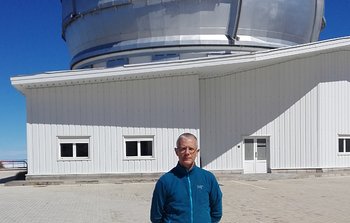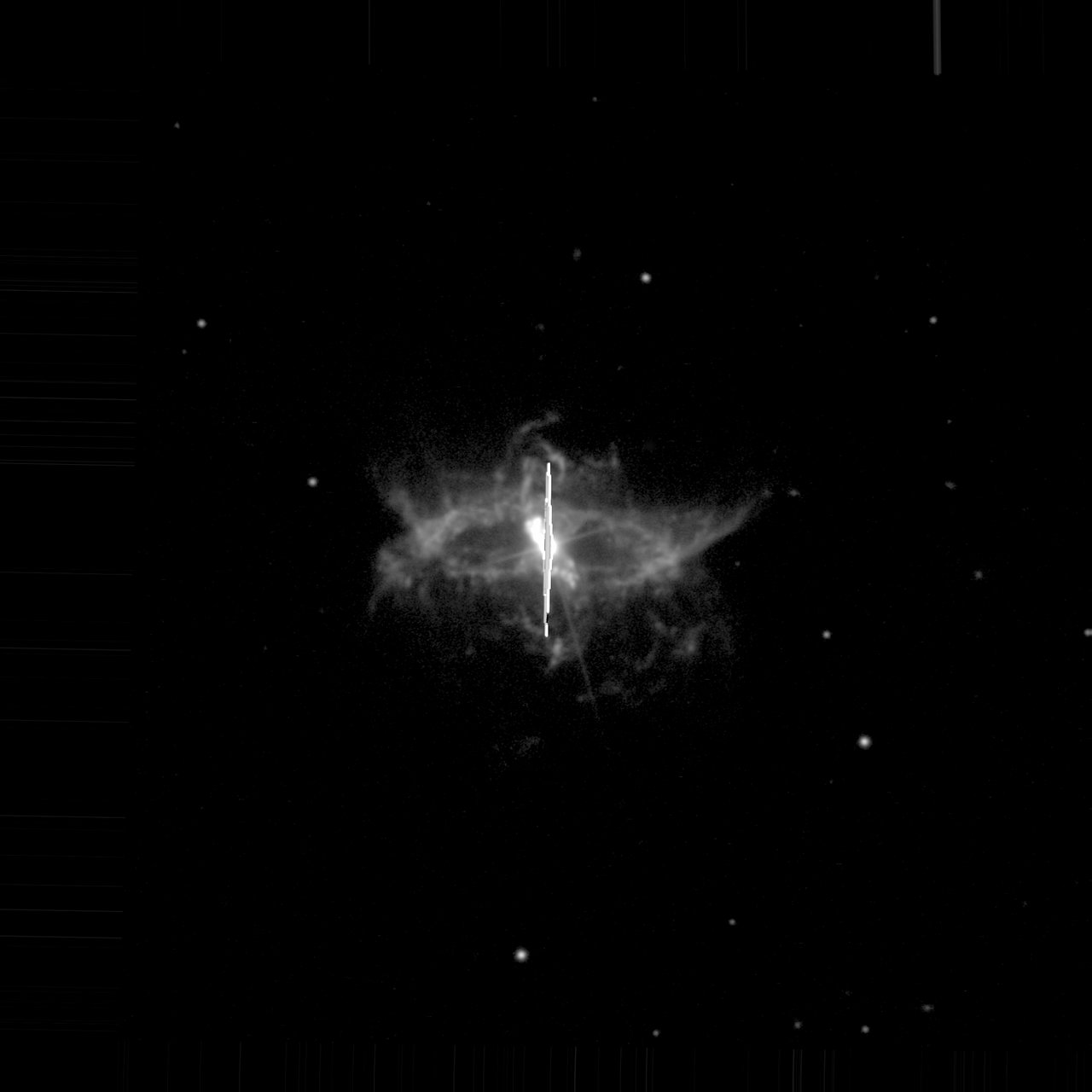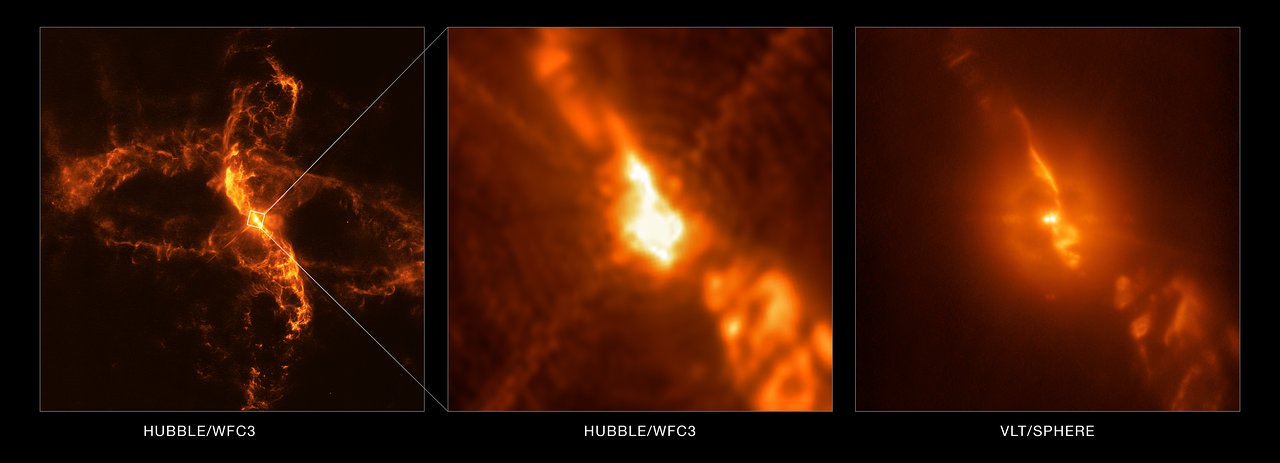
Monitoring the changing R Aquarii
Three generations of astronomy in the last installment of ESO’s R Aquarii week
- What a symbiotic star is and what they can teach us about the Universe
- More about symbiotic star R Aquarii, as part of ESO’s R Aquarii week
- What astronomers have found out through thirty years of observing R Aquarii
I am particularly interested in R Aquarii because it is a symbiotic star — two interacting stars locked in a binary system in which a hot white dwarf strips away matter from a nearby cool giant star. In the case of R Aquarii, the giant is a highly evolved pulsating star reaching the end of its life; it will soon completely shed its external gaseous envelope to become a white dwarf just like its partner.
The mass pulled away from this giant star creates an extended complex nebula that is further shaped by the surplus material that the white dwarf occasionally ejects to create loops and arcs. An accretion disk around the white dwarf sends out a jet of hot X-ray emitting material. This is the source of the S-shaped feature visible in the main photo above, which we took using ESO’s Very Large Telescope in 2012. At a distance of 650 light-years, R Aquarii is one of the closest known symbiotic systems and offers a unique opportunity to find out more about these special stars.
One of the most challenging aspects of astronomy is that things change extremely slowly, so it can be difficult to study the dynamical nature of systems like R Aquarii, for example how fast they expand. We can only see how systems evolve by regularly taking images of them.
My PhD supervisor, Hugo Schwarz, began imaging and studying R Aquarii in the mid-1980s, and I joined him as a PhD student in 1991. Over the years I have continued to study the symbiotic star system, and now work on the research with my own PhD students. By combining 30 years of observations, and three generations of scientific ideas and expertise, we now have a good idea of how the system evolves. But two of the key ingredients of this project really have been patience and perseverance.
Our work has changed a lot during this time. When I joined 27 years ago, image processing was extremely slow and direct human interaction was needed at every stage in making observations. No real pre-existing codes for processing raw data were available for most astronomical instruments, just basic guides or “recipes”. In addition to this, in the early nineties we typically had to be physically present at a telescope to observe, but nowadays we are often able to use telescopes remotely — almost from the comfort of our own homes! Improved computing power has of course made a huge difference to us. I was lucky to appear on the “astronomy scene” when large and highly efficient CCDs became commonly available in astronomical observatories. This all combined to make our research much more efficient.
When I arrived at ESO’s La Silla Observatory as a student, I had the chance to take advantage of the superb image quality of the recently installed New Technology Telescope (NTT). The NTT really was a step forward in measuring the fine details necessary to follow the apparent growth of nearby nebulae. Since then, we have used several telescopes for our work, mainly at ESO and at the Observatorio del Roque de los Muchachos on La Palma.
Because R Aquarii is large and fairly close, it is relatively easy to observe the region around the central binary system out to the place where the outflow mixes with the interstellar medium. At such scales, we see the imprint of the initial “kick” of the outflow. But in order to study the central “engine”, higher spatial resolutions were needed, such as those provided by the SPHERE instrument on the VLT.
Now a team of scientists led by Hans Martin Schmid from ETH Zurich University has actually used SPHERE to image the innermost regions of R Aquarii in extraordinary detail — even better than can be done from space — enabling them to resolve the source of the jet to further investigate how it is launched into space. It also marks the first time that we can resolve the red giant and white dwarf in this binary system.
R Aquarii is not the only “large-scale structure” this research could help us understand, in fact the information could revolutionise our understanding of the formation and evolution of astrophysical jets. Using SPHERE to image R Aquarii was really a test to see how much the instrument’s new ZIMPOL camera could help with investigating all of these systems in more detail than ever before. The team found that the SPHERE images were of an incredible quality, as well as being complementary to Hubble observations.
The timelapse below shows just how much R Aquarii has changed over the last 20 years. At the beginning of the video, we see an image from the Nordic Optical Telescope (NOT) taken in 1997. This is combined with another NOT image from 2007 and a VLT image from 2012 to show how the nebula is growing over time. We can even see how different parts of the system expand with different speeds, for example the white jet grows particularly fast. It is so rare to be able to see theis kind of evolution in astronomy, and I think it’s amazing!
I would like to conclude by saying, while it may not immediately pay dividends in terms of the number of articles published, the legacy value of long-term, systematic monitoring of celestial sources — such as the one that we are doing on nearby stellar outflows — is potentially enormous, and often even unrepeatable.
Numbers in this article
| 650 | Distance to R Aquarii in light-years. |
| 1980s | When Hugo Schwarz began imaging and studying R Aquarii. |
| 1991 | Year that Romano started studying R Aquarii as a PhD student. |
| 2012 | Year that Romano observed R Aquarii using the VLT. |
Links
Biography Romano Corradi
Born in Italy, Romano Corradi received a PhD in Astrophysics from Padova University. After working at La Silla Observatory from 1991–1993, he moved to the Canary islands with a fellowship from one of the first mobility programmes of the European Union. Since then, he worked at the Instituto de Astrofisica de Canarias and later at the Isaac Newton Group of telescopes. He is now a staff researcher at the IAC and, since 2016, is the director of the 10.4-metre Gran Telescopio Canarias (GTC). His main scientific interests are the late stages of stellar evolution, and the chemistry of the interstellar medium in the nearby Universe.




